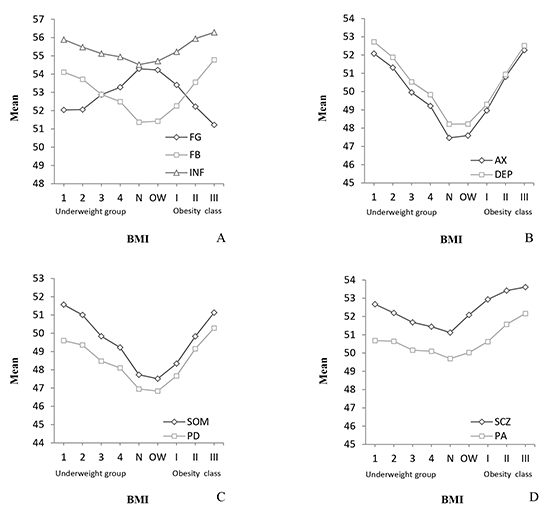1. Subramaniam M, Picco L, He V, Vaingankar JA, Abdin E, Verma S, Rekhi G, Yap M, Lee J, Chong SA. Body mass index and risk of mental disorders in the general population: results from the Singapore Mental Health Study. J Psychosom Res. 2013; 74:135–141.
2. McCarthy JF, Ilgen MA, Austin K, Blow FC, Katz IR. Associations between body mass index and suicide in the veterans affairs health system. Obesity (Silver Spring). 2014; 22:269–276.
3. Stanley SH, Laugharne JD, Addis S, Sherwood D. Assessing overweight and obesity across mental disorders: personality disorders at high risk. Soc Psychiatry Psychiatr Epidemiol. 2013; 48:487–492.
4. Scott KM, McGee MA, Wells JE, Oakley Browne MA. Obesity and mental disorders in the adult general population. J Psychosom Res. 2008; 64:97–105.
5. Scott KM, Bruffaerts R, Simon GE, Alonso J, Angermeyer M, de Girolamo G, Demyttenaere K, Gasquet I, Haro JM, Karam E, et al. Obesity and mental disorders in the general population: results from the world mental health surveys. Int J Obes (Lond). 2008; 32:192–200.
6. Hu HY, Wu CY, Chou YJ, Huang N. Body mass index and mental health problems in general adults: disparity in gender and socioeconomic status. J Psychosom Res. 2012; 72:393–398.
7. Barry D, Pietrzak RH, Petry NM. Gender differences in associations between body mass index and DSM-IV mood and anxiety disorders: results from the National Epidemiologic Survey on Alcohol and Related Conditions. Ann Epidemiol. 2008; 18:458–466.
8. Crisp AH, McGuiness B. Jolly fat: relation between obesity and psychoneurosis in general population. Br Med J. 1976; 1:7–9.
9. Palinkas LA, Wingard DL, Barrett-Connor E. Depressive symptoms in overweight and obese older adults: a test of the "jolly fat" hypothesis. J Psychosom Res. 1996; 40:59–66.
10. Revah-Levy A, Speranza M, Barry C, Hassler C, Gasquet I, Moro MR, Falissard B. Association between Body Mass Index and depression: the "fat and jolly" hypothesis for adolescents girls. BMC Public Health. 2011; 11:649.
11. Jasienska G, Ziomkiewicz A, Górkiewicz M, Pajak A. Body mass, depressive symptoms and menopausal status: an examination of the "Jolly Fat" hypothesis. Womens Health Issues. 2005; 15:145–151.
12. Magnusson PK, Rasmussen F, Lawlor DA, Tynelius P, Gunnell D. Association of body mass index with suicide mortality: a prospective cohort study of more than one million men. Am J Epidemiol. 2006; 163:1–8.
13. Zhao G, Ford ES, Li C, Strine TW, Dhingra S, Berry JT, Mokdad AH. Serious psychological distress and its associations with body mass index: findings from the 2007 Behavioral Risk Factor Surveillance System. Int J Public Health. 2009; 54:30–36.
14. Martinez EV, Gutiérrez-Bedmar M, García-Rodríguez A, Mariscal A, Muñoz-Bravo C, Navajas JF. Weight status and psychological distress in a Mediterranean Spanish population: a symmetric U-shaped relationship. Nutrients. 2014; 6:1662–1677.
15. McCrea RL, Berger YG, King MB. Body mass index and common mental disorders: exploring the shape of the association and its moderation by age, gender and education. Int J Obes (Lond). 2012; 36:414–421.
16. de Wit LM, van Straten A, van Herten M, Penninx BW, Cuijpers P. Depression and body mass index, a u-shaped association. BMC Public Health. 2009; 9:14.
17. Subotnik KL, Asarnow RF, Nuechterlein KH, Fogelson DL, Thorpe TI, Payne DL, Giannini CA, Kuppinger HE, Torquato RD, Mintz J, et al. MMPI vulnerability indicators for schizophrenia and attention deficit disorder: UCLA family study of biological parents of offspring with childhood-onset schizophrenia or ADHD. Behav Genet. 2005; 35:159–175.
18. Hathaway SR. McKinley JC, editor. The Minnesota multiphasic personality inventory. Minneapolis: The University of Minnesota Press;1943.
19. Lahey BB, Russo MF, Walker JL, Piacentini JC. Personality characteristics of the mothers of children with disruptive behavior disorders. J Consult Clin Psychol. 1989; 57:512–515.
20. Lee SJ, Kwon JH, Lee YJ. Personality characteristics of mothers of children with attention deficit hyperactivity disorder as assessed by the Minnesota multiphasic personality inventory. Psychiatry Investig. 2008; 5:228–231.
21. Physical status: the use and interpretation of anthropometry. Report of a WHO Expert Committee. World Health Organ Tech Rep Ser. 1995; 854:1–452.
22. Lee JG, Nam WM. The evaluation of the Korean military personality inventory. In : Korean Psychological Association Annual Conference; Seoul: Korean Psychological Association;2006. p. 466–467.
23. Lee JG, Nam WM, Park JH, Lim HS, Yoon HH, Han JH. The relationship between the KMPI and the military personality inventory. In : Korean Psychological Association Annual Conference; Seoul: Korean Psychological Association;2006. p. 464–465.
24. Won HT, Han DW, Sin ES, Park KB, Lee YH, Yuk SP. Final report on development study of military personality inventory. Seoul: Korean Psychological Association;1998.
25. Choi KH, Jung SG, Choi KP, Moon CB, Kim JM. Report No.Un07-2699. Development of new military personality inventory. Seoul: Korea Institute for Defense Analyses;2009.











 PDF
PDF ePub
ePub Citation
Citation Print
Print




 XML Download
XML Download